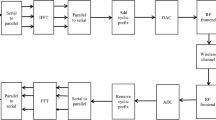Abstract
Previous work on transmitter antenna diversity has shown that the use of multiple transmitter antennas at the base station results in improved performance due to increase of diversity (path diversity). This happens with no bandwidth cost, even when the signal quality along several paths is poor, but the receiver estimates the channel with accuracy. This paper evaluates the effects of channel estimation errors in the performance of the schemes designated as Space-Time Transmitter Diversity (STTD) and Selective Transmitter Diversity (STD). We consider low to medium signal to noise ratios characteristic of Wideband Code Division Multiple Access (WCDMA) networks. Different fading channel models are considered for comparison between the two schemes. The improvement due to convolutional coding associated with these techniques is also evaluated.
Similar content being viewed by others
References
V. Tarokh, N. Seshadri and A. Calderbank, “Space-Time Codes for High Data Rate Wireless Communication: Performance Criterion and Code Construction”, IEEE Trans. on Information Theory, pp. 744-765, 1998.
S.M. Alamouti, “A Simple Transmitter Diversity Scheme for Wireless Communications”, IEEE Journal on Sel. Areas in Comm., pp. 1451-1458, 1998.
A. Naguib, V. Tarokh, N. Seshadri and A. Calderbank, “Space-Time Codes for High Data Rate Wireless Communication: Modem Design”, IEEE Journal on Sel. Areas in Comm., pp. 1459-1478, 1998.
V. Tarokh, H. Jafarkhani and A. Calderbank, “Space-Time Block Coding for Wireless Communications: Theory of Generalized Orthogonal Designs”, IEEE Trans. on Information Theory, to appear.
Nokia, Samsung, “UTRA FDD Downlink Transmission Diversity Concept”, Tdoc SMG2 315 UMTS, L1/98, Helsinki, Finland, September 1998.
A. Hottinen and R. Wichman, “Transmit Diversity Techniques for WCDMA”, in 5th Annual Smart Antennas Workshop, Stanford University, July 1998. “Diversity and Coding for Indoor Radio”, IEEE Journal on Select. Areas Comm., Vol. 10, pp. 705-713, 1992.
Motorola, “Orthogonal Transmit Diversity for CDMA Forward Link”, FPLMTS Study Committee, Air-Interface WG, SWG2, Doc. no. AIF/SWG-2-16-26.
J.G. Proakis, Digital Communications, McGraw-Hill, 1995.
V. Silva and E. Sousa, “Fading-resistant Transmission from Several Antennas”, in Proc. of IEEE PIMRC'95, pp. 1218-1222, 1995.
P. Diaz and R. Augusti, “The Use of Coding and Diversity Combining for Multigating Fading Effects in a DS-CDMA System”, IEEE Trans on Vehicular Techn., Vol. 47, pp. 95-101, 1998.
A. Wittneben, “A New Bandwidth Efficient Transmit Antenna Modulation Diversity Scheme for Linear Digital Modulation”, in Proc. of IEEE ICC'93, pp. 1630-1634, 1993.
J. Guey, M. Fitz, M. Bell and W. Kuo, “Signal Design for Transmitter Diversity Wireless Communication Systems over Rayleigh Fading Channels”, in Proc. of IEEE VTC'96, pp. 136-140, 1996.
D. Rhee and S. Rajpal, “Some Block and Trellis-Coded Modulations for the Rayleigh Fading Channel”, Trans on Comm., Vol. 44, pp. 34-42, 1996.
A.M.C. Correia, “Commutation Signaling to Combat ISI over Nakagami and Ricean Fading”, Wireless Personal Communications, Kluwer Pub., pp. 213-231, 1998.
A. Correia, A. Hottinen and R. Wichman, “Space-Time Transmitter Diversity Schemes for Wideband CDMA”, in Proceedings of IEEE VTC2000, Tokyo, Japan, May 2000.
3GPP TS 25.2111, “Physical Channels and Mapping of Transport Channels onto Physical Channels (FDD)”, Release 1999.
E. Lindskog and A. Paulraj, “A Transmit Diversity Scheme for Channels with Intersymbol Interference”, in Proceedings of IEEE ICCC2000, New Orleans, U.S.A., June 2000.
E. Al-Hussaini, I. Sayed and E. Saad, “Selection and MRC Diversity for a DS/CDMA Mobile Radio System through Nakagami Fading Channel”, Wireless Personal Communications, Kluwer Pub., to be published.
P. van Rooyen, M. Lotter and D. van Wyk, Space-Time Processing for CDMA Mobile Communications, Kluwer Acad. Pub., 2000.
Author information
Authors and Affiliations
Rights and permissions
About this article
Cite this article
Correia, A. Transmit Diversity Schemes for WCDMA. Wireless Personal Communications 25, 65–85 (2003). https://doi.org/10.1023/A:1023655325679
Issue Date:
DOI: https://doi.org/10.1023/A:1023655325679




